Alexandrine Parrot Care: 10 Essential Tips for Happy, Healthy Birds
The alexandrine parrot stands as one of the most magnificent and intelligent companion birds in the avian world. These emerald-feathered beauties, scientifically known as Psittacula eupatria, captivate bird enthusiasts with their striking appearance and remarkable cognitive abilities. Proper alexandrine parrot care requires dedication, knowledge, and understanding of their unique needs to ensure these majestic creatures thrive in captivity.
Native to the Indian subcontinent and Southeast Asia, the alexandrine parrot has earned its reputation as a charismatic and long-lived companion. Their distinctive red shoulder patches, vibrant green plumage, and impressive size make them a coveted choice among experienced bird keepers. However, successful alexandrine parrot ownership demands more than admiration – it requires comprehensive care strategies that address their physical, mental, and emotional well-being.
Table of Contents:
Understanding the Alexandrine Parrot Species
Physical Characteristics and Natural Behavior
The alexandrine parrot typically measures 23 inches in length, making them one of the larger members of the ringneck parrot family. Adult males develop a distinctive black and rose-colored collar around their necks, while females maintain a more uniform green appearance. These birds possess powerful beaks designed for cracking nuts and seeds in their natural habitat.
In the wild, alexandrine parrot flocks exhibit complex social behaviors, engaging in elaborate communication patterns and hierarchical structures. Understanding these natural tendencies proves crucial for domestic care, as captive birds retain many instinctual behaviors that influence their care requirements.
Lifespan and Development Stages
A well-cared-for alexandrine parrot can live between 25 to 30 years, with some exceptional individuals reaching 40 years. This longevity makes them a significant commitment, requiring consistent care throughout various life stages. Young alexandrine birds require different nutritional and social needs compared to mature adults, necessitating adaptive care approaches.
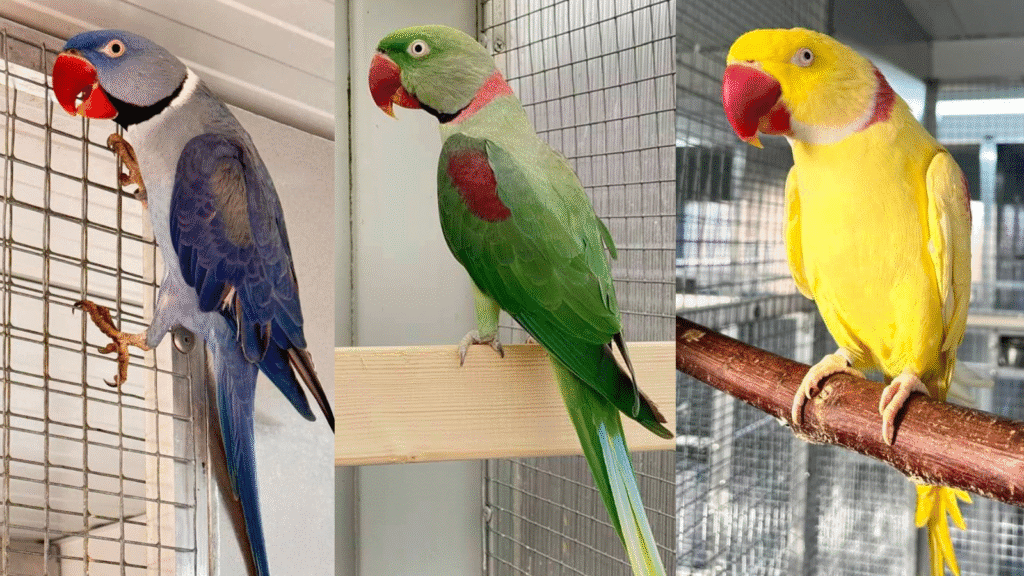
Essential Tip 1: Creating the Perfect Habitat
Cage Size and Specifications
The alexandrine parrot requires spacious accommodations due to their impressive wingspan and active nature. Minimum cage dimensions should measure 40 inches wide, 30 inches deep, and 60 inches tall. However, larger enclosures significantly enhance their quality of life and allow for natural movement patterns.
Bar spacing between ¾ to 1 inch prevents escape while ensuring adequate ventilation. Horizontal bars encourage climbing behavior, which alexandrine birds naturally enjoy. Stainless steel or powder-coated materials resist corrosion from their powerful beaks and frequent cleaning requirements.
Environmental Enrichment Elements
Strategic placement of perches at varying heights and diameters promotes foot health and prevents pressure sores. Natural wood branches from safe tree species like apple, willow, or birch provide texture variation and encourage natural chewing behaviors essential for alexandrine parrot well-being.
Essential Tip 2: Optimal Nutrition for Alexandrine Parrots
Foundation Diet Components
A balanced alexandrine parrot diet consists of high-quality pellets comprising 60-70% of total food intake. Premium pellet brands formulated specifically for large parrots provide essential vitamins, minerals, and amino acids crucial for maintaining optimal health.
Fresh vegetables should constitute 20-25% of their daily nutrition. Dark leafy greens like kale, spinach, and collard greens offer vital nutrients. Colorful vegetables including carrots, bell peppers, and broccoli provide antioxidants and enhance immune system function in alexandrine parrot birds.
Supplementary Foods and Treats
Healthy seeds and nuts serve as excellent training rewards and mental stimulation tools. Sunflower seeds, pumpkin seeds, and unsalted almonds appeal to alexandrine parrot preferences while providing healthy fats and proteins. However, these high-fat foods should comprise no more than 10% of their total diet.
Fresh fruits offer natural sugars and vitamins but require moderation due to their sugar content. Apples, berries, and tropical fruits like papaya provide variety and enrichment opportunities for alexandrine parrot feeding routines.
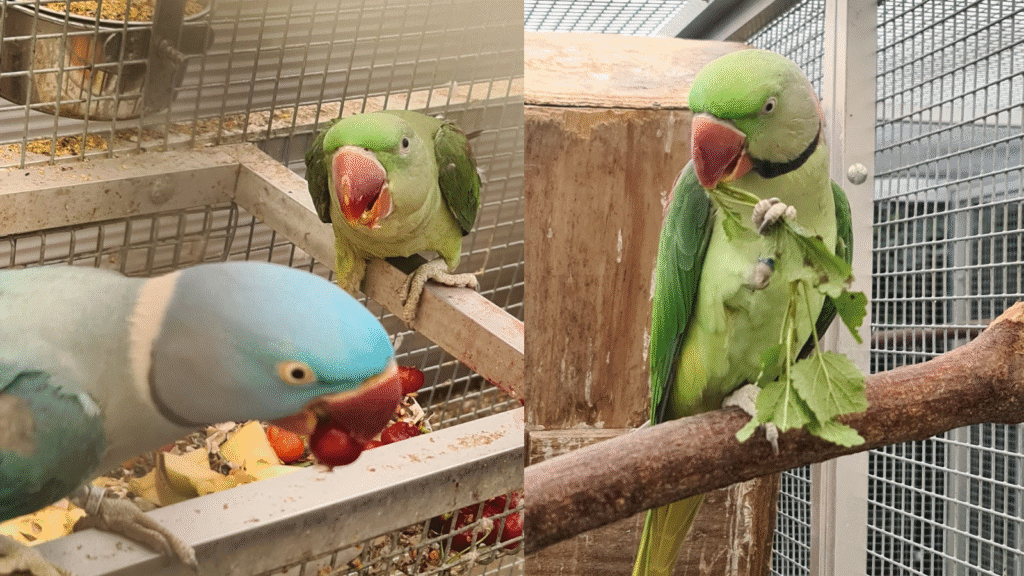
Essential Tip 3: Establishing Proper Hygiene Protocols
Daily Cleaning Routines
Maintaining pristine conditions prevents bacterial growth and disease transmission in alexandrine parrot environments. Daily removal of uneaten food, droppings, and soiled cage accessories ensures a healthy living space. Fresh water changes twice daily prevent contamination and encourage adequate hydration.
Food and water bowls require thorough washing with bird-safe cleaning solutions. Stainless steel or ceramic dishes resist bacterial growth better than plastic alternatives, making them ideal for alexandrine parrot use.
Weekly Deep Cleaning Procedures
Comprehensive cage sanitization involves disassembling removable components for thorough cleaning. Bird-safe disinfectants eliminate harmful pathogens while remaining non-toxic to sensitive alexandrine parrot respiratory systems. Perches, toys, and cage bars require individual attention to remove accumulated debris and bacteria.
Essential Tip 4: Mental Stimulation and Enrichment
Toy Selection and Rotation
The intelligent alexandrine parrot requires constant mental challenges to prevent boredom and destructive behaviors. Puzzle toys, foraging devices, and interactive feeders stimulate their problem-solving abilities and mimic natural food-seeking behaviors.
Rotating toys weekly maintains novelty and sustained interest. Different textures, colors, and mechanisms appeal to various aspects of alexandrine parrot intelligence and curiosity. Wooden toys satisfy their natural chewing instincts while providing entertainment.
Training and Socialization Activities
Regular training sessions strengthen the human-alexandrine parrot bond while providing mental exercise. Teaching simple commands, tricks, and flight recall enhances their cognitive development and creates positive interaction opportunities.
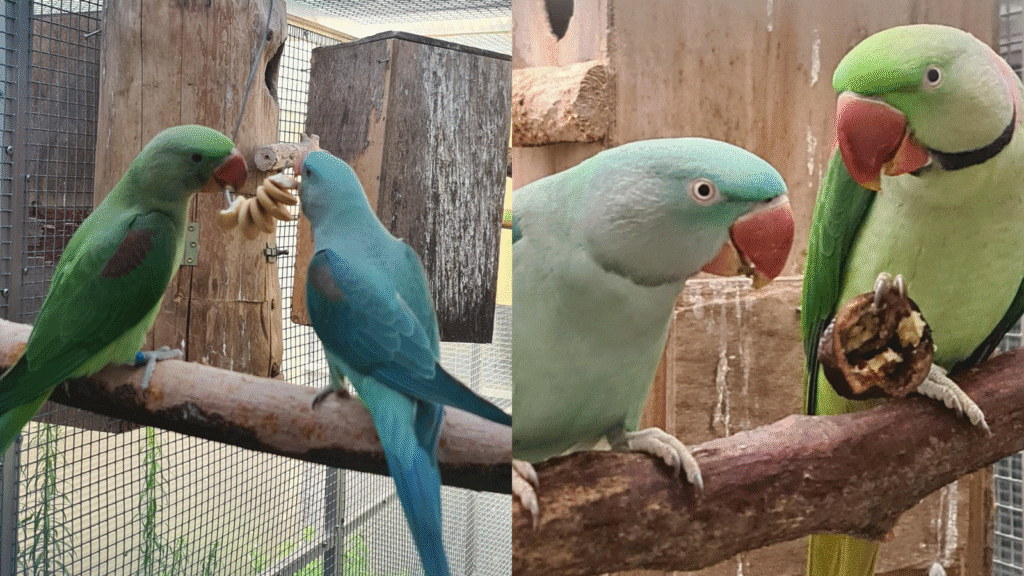
Essential Tip 5: Temperature and Environmental Controls
Optimal Climate Conditions
Alexandrine parrot birds thrive in temperatures between 65-78°F with humidity levels around 50-60%. Sudden temperature fluctuations stress their systems and compromise immune function. Gradual seasonal adjustments help them acclimate naturally to changing conditions.
Adequate ventilation prevents stagnant air while avoiding direct drafts that can cause respiratory issues in sensitive alexandrine parrot individuals. Air purifiers help maintain clean air quality, especially important for birds with delicate respiratory systems.
Lighting Requirements
Natural daylight cycles regulate alexandrine parrot hormonal patterns and behavioral rhythms. Providing 10-12 hours of bright light followed by uninterrupted darkness supports their circadian rhythms and overall health.
Full-spectrum lighting supplements natural sunlight, particularly beneficial during winter months or in windowless rooms. UV-B exposure aids calcium absorption and vitamin D synthesis crucial for alexandrine parrot bone health.
Essential Tip 6: Health Monitoring and Veterinary Care
Recognizing Health Indicators
Daily observation helps identify subtle changes in alexandrine parrot behavior, appetite, or appearance that may indicate health concerns. Healthy birds exhibit bright eyes, smooth feathers, active behavior, and consistent eating patterns.
Warning signs include lethargy, changes in droppings, respiratory symptoms, or decreased vocalization. Early detection significantly improves treatment outcomes for alexandrine parrot health issues.
Preventive Medical Care
Annual veterinary examinations by avian specialists ensure optimal alexandrine parrot health maintenance. These checkups include physical examinations, weight monitoring, and diagnostic tests to detect potential problems before they become serious.
Routine blood panels, fecal examinations, and crop cultures provide baseline health data for each individual alexandrine parrot. Vaccination schedules and parasite prevention protocols depend on regional disease risks and veterinary recommendations.
Essential Tip 7: Social Interaction and Bonding
Building Trust and Relationships
Alexandrine parrot birds are highly social creatures requiring regular interaction for emotional well-being. Consistent, gentle handling builds trust and strengthens the human-bird bond essential for successful long-term companionship.
Respecting their body language and communication signals prevents stress and promotes positive relationships. Understanding alexandrine parrot behavioral cues helps owners respond appropriately to their needs and emotions.
Managing Multiple Bird Households
When housing multiple alexandrine parrot birds, careful introduction protocols prevent territorial conflicts and ensure harmonious coexistence. Gradual introduction processes and adequate space allocation reduce stress and competition.
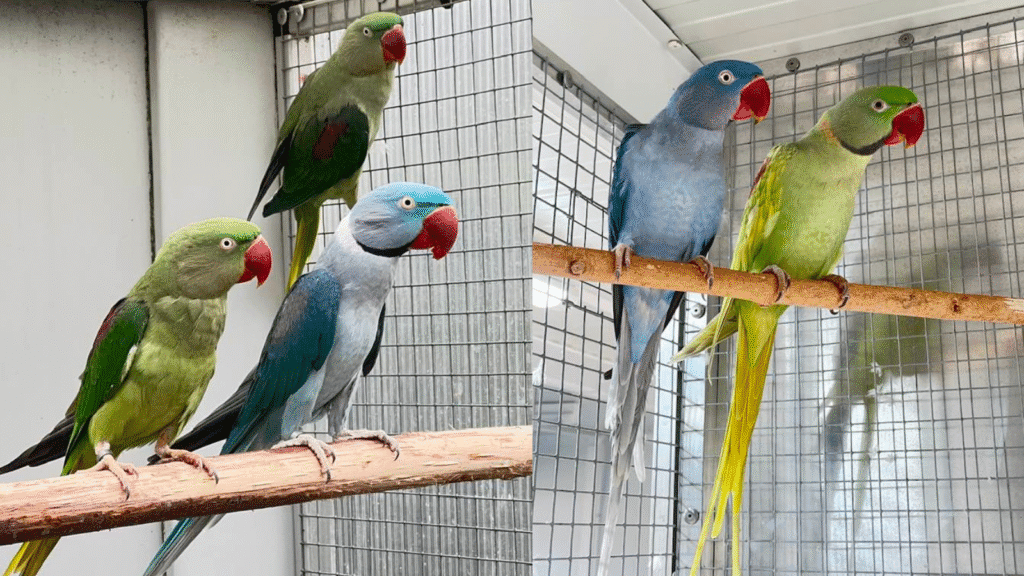
Essential Tip 8: Exercise and Physical Activity
Flight Opportunities
Alexandrine parrot birds require regular flight exercise to maintain cardiovascular health and muscle tone. Supervised out-of-cage time in bird-proofed rooms provides essential physical activity and mental stimulation.
Flight training enhances their natural abilities while strengthening the owner-bird relationship. Recall training ensures safe free-flight experiences and builds confidence in both bird and owner.
Climbing and Movement Activities
Providing varied perching options and climbing structures encourages natural movement patterns essential for alexandrine parrot physical health. Play gyms, rope bridges, and ladder systems create engaging activity centers.
Essential Tip 9: Breeding Considerations and Reproductive Health
Hormonal Management
Alexandrine parrot birds may exhibit hormonal behaviors during breeding seasons, including increased aggression, territorial behavior, or excessive vocalization. Understanding these natural cycles helps owners manage challenging periods effectively.
Environmental modifications like adjusted lighting schedules and reduced nest-like spaces can help moderate hormonal responses in pet alexandrine parrot birds not intended for breeding.
Breeding Requirements for Interested Owners
Serious breeding efforts require extensive knowledge, proper facilities, and significant time commitments. Alexandrine parrot breeding pairs need spacious flight cages, appropriate nesting boxes, and specialized nutrition during reproductive periods.
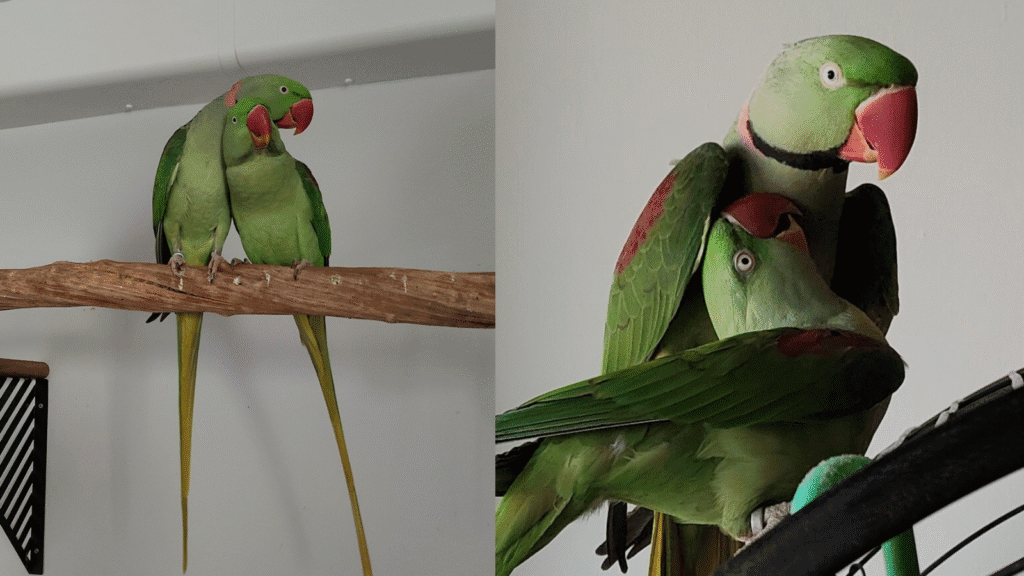
Essential Tip 10: Long-term Care Planning
Commitment Understanding
Owning an alexandrine parrot represents a decades-long commitment requiring consistent care, financial resources, and lifestyle accommodations. These intelligent birds form strong bonds and require stability throughout their extended lifespans.
Estate planning considerations ensure continued care if owners become unable to provide for their alexandrine parrot companions. Establishing care networks and backup plans protects these long-lived birds from abandonment or inadequate care.
Ongoing Education and Adaptation
Successful alexandrine bird care requires continuous learning about advancing care techniques, nutritional research, and behavioral understanding. Joining bird clubs, attending seminars, and consulting with experienced owners enhances care quality.
Common Challenges and Solutions
Behavioral Issues
Alexandrine birds may develop problematic behaviors like excessive screaming, feather plucking, or aggression without proper care and attention. Addressing underlying causes through environmental modifications, increased socialization, and veterinary consultation often resolves these issues.
Nutritional Deficiencies
Poor diet quality contributes to numerous health problems in alexandrine birds. Working with avian veterinarians to develop appropriate nutrition plans prevents deficiency-related diseases and promotes longevity.
Building a Support Network
Finding Qualified Professionals
Establishing relationships with experienced avian veterinarians, bird behaviorists, and knowledgeable bird stores creates a support system for alexandrine bird care challenges. These professionals provide expert guidance for complex situations.
Community Resources
Connecting with other alexandrine bird owners through online forums, local bird clubs, and social media groups provides valuable experience sharing and emotional support throughout the ownership journey.
Conclusion
Caring for an alexandrine bird requires dedication, knowledge, and genuine commitment to their well-being. These magnificent birds reward proper care with decades of companionship, intelligence, and beauty that enriches their owners’ lives immeasurably.
Success with alexandrine bird ownership comes from understanding their complex needs and providing consistent, high-quality care throughout their extended lifespans. The investment in proper housing, nutrition, veterinary care, and enrichment creates the foundation for a thriving human-bird relationship.
By following these essential care guidelines, alexandrine bird owners can ensure their feathered companions live healthy, happy, and fulfilling lives as cherished family members. The rewards of proper alexandrine bird care extend far beyond the initial investment, creating lasting memories and deep bonds that define the true joy of bird ownership.
FAQ
How much space does an alexandrine parrot need for proper care?
An alexandrine parrot requires a minimum cage size of 40″W x 30″D x 60″H, though larger is always better. They also need daily supervised out-of-cage time for exercise and socialization.
How often should I take my alexandrine parrot to the veterinarian?
Annual checkups with an avian veterinarian are essential for preventive care. Young birds, elderly birds, or those with health concerns may require more frequent visits as recommended by your vet.
Are alexandrine parrots good for first-time bird owners?
Alexandrine parrots are better suited for experienced bird owners due to their size, intelligence, and complex care requirements. They need consistent handling, specialized diets, and extensive social interaction.
What is the average lifespan of a well-cared-for alexandrine parrot?
With proper care, alexandrine parrots typically live 25-30 years, with some exceptional individuals reaching 40 years. Their longevity makes them a significant long-term commitment.
Did you enjoy this article?
Help other pet lovers benefit too — Share it on social media! 🐾💚


Leave a Reply